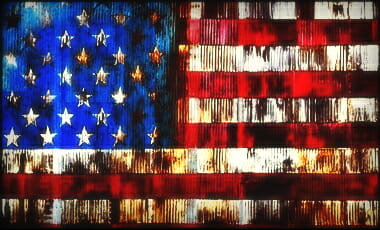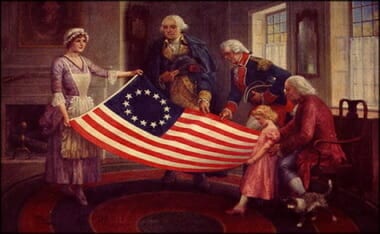Prior to the 4th, Michael Medved recaps with his “Golden Turkey Award” the insane positions taken by the Left regarding the Betsy Ross flag and our Nation’s Founding.
3 Ignorant Myths About The Betsy Ross Flag, Dispelled (THE FEDERALIST):
….Men, women, rich, poor, black and white—all fought and made sacrifices for the principles and aspirations that this flag represents. After the last major battle of the American Revolution, Congress deepened the flag’s meaning by defining red, white and blue.
“White signifies purity and innocence. Red hardiness and valor and Blue … signifies vigilance perseverance and justice,” the Journal of the Continental Congress recorded on June 20, 1782.
Why didn’t Congress define the colors when they first adopted the flag in 1777? They didn’t really know what the colors meant at the start of the United States. By the end of the revolution, they knew what those colors meant because they understood the cost of freedom.
They knew that a free African-American named Peter Salem lived for the red stripe of valor when he risked his life at Bunker Hill to take out the British major responsible for the first British shots of the war. Because of Salem’s story, more Africans were freed and fought. Salem fought for four years and Africans made up about four percent of the Continental Army.
They knew that the flag’s maker, Betsy Ross, was an antislavery Quaker. Her second husband, Joseph Ashburn, was thrown into a British prison for “piracy, treason and rebellion against His Majesty on the high seas.” Representing the white stripe’s pure motive of loyalty, he died because he pledged allegiance to the flag of unity that his wife first sewed.
They knew that a slave named James Armistead represented the color blue because his vigilance as a spy led to America’s victory in the final battle at Yorktown in 1781. Without Armistead’s intelligence as a servant to British General Cornwallis, General Lafayette would not have been able to notify Washington that seizing Yorktown was possible. When Amistead became a free man, he changed his name to James Lafayette.
Yes, it’s unfortunately true that slavery existed when America was founded. It’s unfortunately true that freedom was not equally applied after the American Revolution, with only states in the North abolishing slavery over our nation’s initial years and first decades. It is unfortunately true that the quest for freedom and civil rights for all has been a long, hard-fought battle.
It’s also true that America did not change the design of its flag after slavery was abolished. Why? The nation’s leaders after the Civil War did not see a need to alter the flag’s appearance because they outlawed slavery under it. The American flag—the Union flag—was the victor in the Civil War. Except for adding stars each time a state enters the Union, our flag has not changed since the Betsy Ross flag.
The flag’s meaning of unity has not changed. The values of the colors—valor, hardiness, purity, innocence, justice, perseverance, and vigilance—have not changed. The flag has been enhanced and made more brilliant as we have expanded and deepened the meaning of unity and freedom. That is something to celebrate, not denigrate like Nike by refusing to sell a shoe featuring the first flag of the United States of America.
WND has a good overview of a BlaveTV appearance of David Barton regarding Thomas Jefferson and slavery:
…Jefferson continued his abolitionist efforts all through his career.
“When he enters the Continental Congress, he introduces a law to ban slavery in all the colonies,” Barton said. “Every one of them. It failed by one vote.”
He said Jefferson regretted that failure until the end of his life.
Beck noted George Washington freed his slaves upon his death and asked Barton why Jefferson did not follow Washington’s example. Barton explained the American Revolution and the egalitarian ideals led to changes in the law, which made it easier to emancipate slaves. However, Thomas Jefferson had another problem – debt.
“They also had a law that said if you’re in debt you can’t free any slaves,” Barton said. “Jefferson, by today’s standards about two and a half million dollars in debt, is not able to free his slaves, and they changed the laws. He said this: ‘The laws will not allow me to turn them loose.’”
Still, Beck observed that while Jefferson cannot be excused for owning slaves, he not only tried to end slavery in the U.S. but worked to end the institution in other nations, including France. Barton also noted Jefferson paid his slaves, which he didn’t have to do.
Despite Jefferson owning slaves, he was remembered until recently as one of the great anti-slavery crusaders by men such as Frederick Douglass. Barton also recounted the tributes paid to Jefferson by John Quincy Adams, who was called the “hellhound of abolition.” A speech by Adams “praised Jefferson for the lead role he took in trying to end slavery,” Barton said…..


